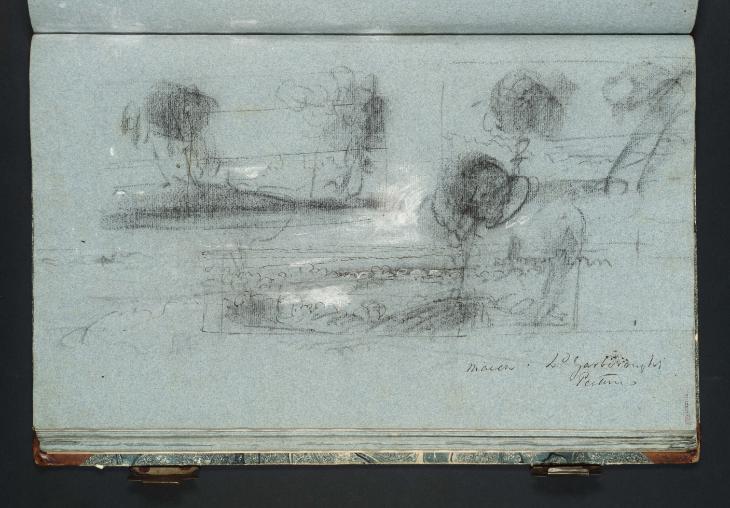Joseph Mallord William Turner Three Composition Studies for 'The Festival upon the Opening of the Vintage of Macon' c.1802-3
Joseph Mallord William Turner,
Three Composition Studies for 'The Festival upon the Opening of the Vintage of Macon'
c.1802-3
Joseph Mallord William Turner 1775–1851
Folio 28 Verso:
Three Composition Studies for ‘The Festival upon the Opening of the Vintage of Macon’ c.1802–3
D04956
Turner Bequest LXXXI 54
Turner Bequest LXXXI 54
Black and white chalks with pen and brown ink on blue laid paper, 271 x 436 mm
Watermarks ‘1794’ and ‘VI’
Inscribed by Turner in ink ‘Macon. Ld Yarboroughs | Picture’ bottom right
Inscribed in pencil ‘54’ bottom right, ascending vertically
Stamped in black ‘LXXXI–54’ bottom right, ascending vertically
Watermarks ‘1794’ and ‘VI’
Inscribed by Turner in ink ‘Macon. Ld Yarboroughs | Picture’ bottom right
Inscribed in pencil ‘54’ bottom right, ascending vertically
Stamped in black ‘LXXXI–54’ bottom right, ascending vertically
Accepted by the nation as part of the Turner Bequest 1856
References
1909
A.J. Finberg, A Complete Inventory of the Drawings of the Turner Bequest, London 1909, vol.I, p.215 LXXXI 54 (as ‘Two studies for “Macon. Ld Yarborough’s Picture.”’ 1800–5).
1984
Martin Butlin and Evelyn Joll, The Paintings of J.M.W. Turner, revised ed., New Haven and London 1984, p.36 under no.47.
With the page turned horizontally, these composition studies show Turner’s early thoughts on the subject of The Festival upon the Opening of the Vintage at Macon, the large picture that he showed at the Royal Academy in 1803 (Museums Sheffield).1 There are further, much more specific, studies for the picture on folios 59 verso–60 recto (D05018–D05019; Turner Bequest LXXXI 116–117). It is interesting that, while Turner made these careful preparations for what was to be an important early response to his first visit to the Continent, there exist no drawings made on the spot that might serve as a foundation for his composition.
Indeed, the picture seems to be reliant on works by Claude Lorrain (1604/5–1682) rather on any specific topography; Martin Butlin and Evelyn Joll mention in particular the Landscape with Jacob, Laban and his Daughters2 that Turner might already have seen in the collection of the 3rd Earl of Egremont at Petworth House in West Sussex (now National Trust). This was a work that he was to become intimately acquainted with, and indeed he made a very close pastiche of it in his Apullia in Search of Appullus vide Ovid, shown at the British Institution in 1814 (Tate N00495).3
However, in the first years of the century Turner was probably not familiar with the Egremont collection, though we know that he had been to the town of Petworth as early as 1793: a drawing of about that year has been identified as showing Petworth Church (private collection).4 Butlin and Joll speculate that Turner relied on the engraving of the Egremont picture by William Woollett, published in 1783.5 It was not the first of his pictures to depend on Claudian prototypes: he had already produced two large watercolours of Caernarvon Castle, exhibited at the Royal Academy in 1799 (private collection)6 and 1800 (Tate D04164; Turner Bequest LXX M),7 as well as the oil painting of about 1798, Aeneas and the Sibyl, Lake Avernus (Tate N00463),8 all of which have Claudian compositions; but the Macon was certainly the first really substantial oil painting to announce his devotion to Claude.
As Butlin and Joll note,9 the sketches on this page seem to be principally concerned with the placing of the trees on either side of the foreground, and the bottom one introduces the distant bridge. The deployment of these motifs was to recur throughout Turner’s career: he applied the compositional scheme to views of the Thames at Richmond in Thomson’s Aeolian Harp of 1809 (Manchester Art Gallery),10 in England: Richmond Hill, on the Prince Regent’s Birthday of 1819 (Tate N00502),11 and as late as the mid–1840s in the Landscape with Walton Bridges (private collection).12 It has been suggested that the Macon in fact shows not the Saône but the famous reach of the Thames below Richmond Hill.13 The absence of any drawings of Macon tends to support this contention, though the bridge and buildings in the painting are clearly not English.
The inscription referring to Lord Yarborough must have been added after the Earl bought the picture in 1804; for the dating of the pen and ink inscriptions in this sketchbook, see the Introduction.
Andrew Wilton
May 2013
How to cite
Andrew Wilton, ‘Three Composition Studies for ‘The Festival upon the Opening of the Vintage of Macon’ c.1802–3 by Joseph Mallord William Turner’, catalogue entry, May 2013, in David Blayney Brown (ed.), J.M.W. Turner: Sketchbooks, Drawings and Watercolours, Tate Research Publication, April 2016, https://www

